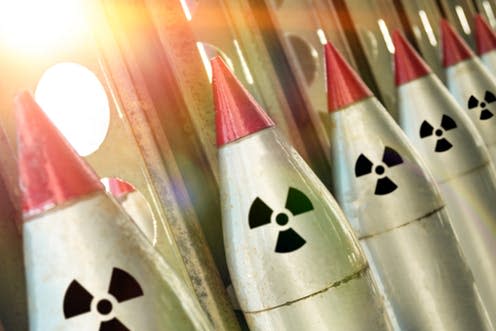No-deal Brexit: preparing for nuclear fallout influenced how government plans for worst-case scenarios

Amid the ongoing political crisis in Westminster, there is still a chance the UK may end up leaving the EU without a deal. And leaked documents from Operation Yellowhammer, the code name for contingency planning in the event of a no-deal Brexit, give apocalyptic projections, including food and water shortages.
At the very core, these preparations are just possibilities and should be seen as an insurance policy against the worst possible outcome. And the civil service has a history of preparing for the worst hypothetically possible outcome for practical and political reasons, stemming back to the days of the Cold War.
Back in the early 1980s, Britain had just spent the previous decade living with economic stagnation and social unease. There were immense geopolitical tensions and anxiety over nuclear war and the radiation that could ensue from a nuclear bomb was relatively high. The government had a mammoth task to reboot the British economy, protect its interests overseas, but also to calm the fears of its own population. Sound familiar?
But there was a problem. Reassuring the public was an almost paradoxical task – on the one hand the government had to play down fears, while on the other hand it couldn’t be seen to be complacent in its forecasts.
Read more: No-deal Brexit: experts on what the UK government's advice means
Protect and survive
Two examples from this period of heightened nuclear anxiety show how the government approached this tricky responsibility.
The first was the Protect and Survive public information series of publications on civil defence, published in the early 1980s. This was meant to inform people about how best to survive a nuclear attack and what would happen in the days and weeks that followed one.
The series had originally been intended for distribution only in the event of dire national emergency but provoked such intense public interest that the pamphlets were authorised for general release so the government was seen to be doing something.
The pamphlet was widely criticised by anti-nuclear activists, including the Campaign for Nuclear Disarmament, and the historian E P Thompson, who published the counter-pamphlet Protest and Survive. This was because it seemed to suggest that you could easily survive a nuclear blast with just a few full stuffed bin bags, along with a few harder objects such as doors and tables to act as the frame for a shelter, and a relatively short supply of food and water.
While the government’s pamphlet was lacklustre in detail, the government conducted extensive planning and ran mock nuclear attack scenarios to test their readiness for an attack, seen in the “If the Bomb Drops” episode of the BBC’s Panorama programme.

Meanwhile, the UK strategy to prevent nuclear attack was to have a nuclear deterrent. Such prevention has become the basis for preparing for seemingly apocalyptic scenarios. Still, in cases where preventing a crisis was not an option, the government planned to prevent the worst-case scenarios from taking place.
After Chernobyl
Such contingency planning was clear in the British government’s response to the Chernobyl incident in 1986, when it was pushed into preparing for future disastrous nuclear incidents for both practical and political reasons. It set up the Civil Contingencies Unit, which made recommendations on how to prevent the loss of life and reduce the damage to public health. These included plans to collect reams of monitoring data on radioactive contamination, and for thousands of buses to evacuate people from an initial exclusion zone of at least 30km and potentially reaching up to 50km around the site of the nuclear incident.
There were earlier examples of the government drawing up contingency plans. But it is the contingency plans after the Chernobyl incident that were a shift in how the government planned for a large scale disaster. Not only would the government prepare for the worst kind of incident that had happened in the past, it would also begin to plan for the worst kind of nuclear incident that could perceivably happen.
This had some consequences for the nuclear industry, which had to ensure the highest standards of safety, ranging from the thickness of concrete to ensuring the supply chains were properly managed.
But there were also wider political implications that arose from this nuclear crisis planning. By setting out the worst imaginable outcome, prevention becomes the best and only real defence against these hypothetical worst-case scenarios.
The no-deal Brexit impact reports are the latest in this pattern. Although the Civil Contingencies Secretariat, one of the groups behind Operation Yellowhammer, was only founded in 2001, its institutional mindset has a history that stretches back to the Cold War. It is a mindset that seeks to set out the worst case scenario and then minimise the risk of it by preventing it from ever occurring.
This article is republished from The Conversation under a Creative Commons license. Read the original article.

Joshua McMullan receives funding from the Arts and Humanities Research Council through the Collaborative Doctoral Partnership. His institutions are the National Archive and the University of Leicester.


